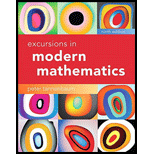
Concept explainers
Exercises 49 through 52 refer to a landmark study conducted in 1896 in Denmark by Dr. Johannes Fibiger, who went on to receive the Nobel Prize in Medicine in 1926. The purpose of the study was to determine the effectiveness of a new serum for treating diphtheria, a common and often deadly respiratory disease in those days. Fibiger conducted his study over a one-year period (May 1896–April 1897) in one particular Copenhagen hospital. New diphtheria patients admitted to the hospital received different treatments based on the day of admission. In one set of days (call them “even” days for convenience), the patients were treated with the new serum daily and received the standard treatment. Patients admitted on alternate days (the “odd” days) received just the standard treatment. Over the one-year period of the study, eight of the 239 patients admitted on the “even” days and treated with the serum died, whereas 30 of the 245 patients admitted on the “odd” days died.
a. Describe the control and treatment groups in Fibiger’s study.
b. What conclusions would you draw from Fibiger’s study? Explain.
Want to see the full answer?
Check out a sample textbook solution
Chapter 14 Solutions
Excursions in Modern Mathematics (9th Edition)
- Write an equation for the polynomial graphed below 5+ 4 - 3 2 1 + + -5 4-3 -2 -1 1 2 3 4 5 -1 -2 y(x) = -3 -4 5 -5+ Qarrow_forwardWrite an equation for the polynomial graphed below 6+ 5 + -5 -4 3 y(x) = 4 3 2 1 -1 1 1 -1 -2 -3 -4 -5 2 3 4 5arrow_forwardWrite an equation for the polynomial graphed below 5+ 4 3 1 + + + -5-4-3-2 1 13 4 5 -1 -2 -3 -4 -5+ 4 5 Q y(x) =arrow_forward
- 1. Name the ongiewing) 2. Name five pairs of supple 3 27 and 19 form a angles 210 and 21 are complementary angies 4. m210=32 mal!= 5 mc11-72 m10= 6 m210-4x mc11=2x x= 7 m210=x m 11 =x+20; x= 12 and 213 are supplementary angles 8 ma 12 2y m13-3y-15 y= 9 m 12-y+10 m13-3y+ 10: y= 10. The measure of 212 is five times the measure of 13. Find the 213 and 214 are complementary angles, and 14 and 15 are supplementary angies 11 mc13 47 m/14- 12 m 14-78 m13- m215- m15 13 m15-135 m. 13- m.14arrow_forward3. Solve the inequality, and give your answer in interval notation. - (x − 4)³ (x + 1) ≥ 0arrow_forward1. Find the formula to the polynomial at right. Show all your work. (4 points) 1- 2 3 сл 5 6 -4 -3 -2 -1 0 2 3arrow_forward
- 2. Find the leading term (2 points): f(x) = −3x(2x − 1)²(x+3)³ -arrow_forward1- √ √ √³ e³/√xdy dx 1 cy² 2- √ √² 3 y³ exy dx dy So 3- √ √sinx y dy dx 4- Jo √² Sy² dx dyarrow_forwardA building that is 205 feet tall casts a shadow of various lengths æ as the day goes by. An angle of elevation is formed by lines from the top and bottom of the building to the tip of the shadow, as de seen in the following figure. Find the rate of change of the angle of elevation when x 278 feet. dx Round to 3 decimal places. Γ X radians per footarrow_forward
- Find The partial fraction decomposition for each The following 2× B) (x+3) a 3 6 X-3x+2x-6arrow_forward1) Find the partial feraction decomposition for each of 5- X 2 2x+x-1 The following: 3 B) 3 X + 3xarrow_forwardUse the information in the following table to find h' (a) at the given value for a. x|f(x) g(x) f'(x) g(x) 0 0 0 4 3 1 4 4 3 0 2 7 1 2 7 3 3 1 2 9 4 0 4 5 7 h(x) = f(g(x)); a = 0 h' (0) =arrow_forward
 Discrete Mathematics and Its Applications ( 8th I...MathISBN:9781259676512Author:Kenneth H RosenPublisher:McGraw-Hill Education
Discrete Mathematics and Its Applications ( 8th I...MathISBN:9781259676512Author:Kenneth H RosenPublisher:McGraw-Hill Education Mathematics for Elementary Teachers with Activiti...MathISBN:9780134392790Author:Beckmann, SybillaPublisher:PEARSON
Mathematics for Elementary Teachers with Activiti...MathISBN:9780134392790Author:Beckmann, SybillaPublisher:PEARSON
 Thinking Mathematically (7th Edition)MathISBN:9780134683713Author:Robert F. BlitzerPublisher:PEARSON
Thinking Mathematically (7th Edition)MathISBN:9780134683713Author:Robert F. BlitzerPublisher:PEARSON Discrete Mathematics With ApplicationsMathISBN:9781337694193Author:EPP, Susanna S.Publisher:Cengage Learning,
Discrete Mathematics With ApplicationsMathISBN:9781337694193Author:EPP, Susanna S.Publisher:Cengage Learning, Pathways To Math Literacy (looseleaf)MathISBN:9781259985607Author:David Sobecki Professor, Brian A. MercerPublisher:McGraw-Hill Education
Pathways To Math Literacy (looseleaf)MathISBN:9781259985607Author:David Sobecki Professor, Brian A. MercerPublisher:McGraw-Hill Education





